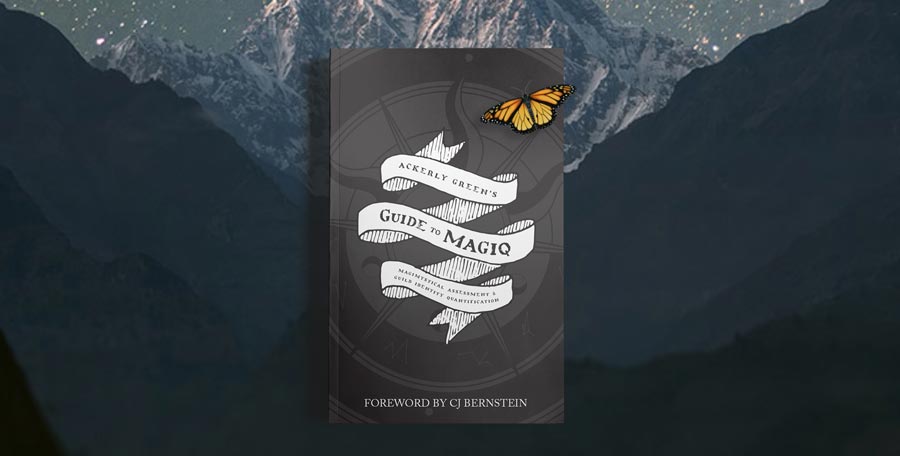

Sometimes, a story lands in my inbox that I just can’t ignore.
I’m used to hearing from authors about their successes and roadblocks in the world of publishing, and I love hearing from people, but every now and again something truly unique comes my way.
Until 2015, CJ Bernstein was a scriptwriter in Hollywood. Within the space of 2 years, CJ had turned his back on the movie world and was breaking into the book world.
fBut, unlike most authors who are getting ready to publish their first book, CJ had built up an audience of thousands of superfans and had already earned thousands of dollars long before his first book was even finished (let alone published).
In today’s article, CJ is breaking down how he used a unique approach to draw readers in, get them signed up to his mailing list, earn revenue from them, AND keep them chomping at the bit for his first book release – all without having a physical or digital book available.
This really is something special…
Enter CJ:

Hollywood Writer to Indie Author – Building An Audience & Sales Before Publishing Your First Book.
– By CJ Bernstein
2015 was a big year for me. A lot of change.
Up until 2015 I had been a working screenwriter for nearly a decade. Writing movies had been my dream since childhood, but Hollywood had changed drastically after the 2007 writers’ strike and there was no longer much interest in original genre material.
They wanted “sure things.” They wanted proven successes. So I kept my head (barely) above water by adapting other peoples’ books, graphic novels, newspaper articles, etc.
I had my dream job, but the truth was that I was frustrated, struggling, and creatively unfulfilled.
During that stretch of time I’d also had an idea for a book—an idea I then tried to sell as a film, a TV show, even a comic book at one point. But no one got it or liked it, or the timing was always wrong. No one was interested, so I let it go.
Well, not really. I loved the world. It was a book about books. And mysterious publishing companies. And secret societies. And magic. And the altered history of the world.
I didn’t really let it go as much as put it aside, and it wasn’t until I was on my honeymoon in 2015, in a library-like hotel room that had hundreds of books lining the two-story walls, that I decided I was going to try and finally write that book.
I needed to do something creatively fulfilling for myself and find another source of satisfaction (and possibly income).
But I still wasn’t ready to quit screenwriting. I needed the fallback. I needed the buffer. I needed to keep my husband from freaking out.

One Book
However, as soon as I started outlining and shaping the story, I realized that it could be more than one book. It could be a world of books. It was about books, after all. And since it was also about mysterious publishing companies…
I thought, why don’t I publish them myself and become the mysterious publishing company? I’d always loved puzzles and alternate-reality games. I could go full “meta” and be the publishing company that created the books in my book!
(This was when my husband started freaking out. A little.)
That had always been the problem, after all. My screenwriting career had always been about me trying to convince people who often weren’t all that creative to do something new and creative. And maybe a little crazy.
So would my book publishing life be the same? Instead of studios, would I be trying to convince publishing houses?
And, yes, there are, of course, creative people working in both industries…but I’d run up against enough Muggles to know I was trading one problem for the same problem, but in a different writing format.
No, I thought. I wasn’t going to write one book. I was going to write a world of books. And I was going to publish them myself.
I was going indie.

Ackerly Green Publishing
Part of being a screenwriter is toiling in varying forms of obscurity and our industry peers treating us with general insouciance. One of the sticking points of the 2007 writers’ strike was that we wanted to ensure we would be given tickets to the premieres of the movies we wrote. That wasn’t a certainty!
So I was used to not having a rallying fan club behind my work. But book writing is different. You need people on your side who rally for you, cheer for you, buy your next book. Or your first book. You need those 10,000 readers.
And I had seven, including my then six-year-old twins.
I know that it’s sound, solid advice for new authors to write two or three books and then go to market. That’s one of the most efficient and successful ways to build your list. While not completely necessary, it’s the more cautious method of gaining a readership. But like I said, I’d wanted to do something new, creative, and a little crazy.
The best way for me to mitigate my and my family’s fear of me giving up my entire career to jump off a literary cliff was to build that readership from the beginning. To know, without a doubt, that when my novel, The Book of Briars, came out, there would already be a devoted audience for it.
Enter the craziest idea I’ve ever had.

The Monarch Papers
With The Book of Briars nearly done I decided that I would write a prequel called The Monarch Papers—a novel that would introduce the characters and concepts of my (admittedly dense and complicated) universe of contemporary magic.
And that prequel would be interactive.
Over the course of a year I would write an online interactive novel where readers could follow the story on blogs and social media.
They could collaborate and form a community on a public forum, interact with fictional characters, and help solve puzzles that would slowly unlock a mysterious site called The Book of Briars, which promised to reveal the truth about our world, if readers and characters worked together to unlock it.
I figured that anyone who stayed involved over the course of a year, unlocking the story and growing invested in the characters, would be eager to buy the book that promised to reveal further secrets and continue the tale.
The Monarch Papers debuted on August 3, 2016. By the fall of 2017, when the story ended, I’d gone from seven followers to just over 3,000. It wasn’t nearly 10,000 (I honestly couldn’t manage 10,000 people in this kind of experience), but in that year, and the months after, I generated income from book-related merchandise like pins, shirts, prints, and novel pre-orders. Combined with an incredible Patreon community, I earn upwards of $1,500-$2,000 a month. I can now pay for artists, designers, and even a part-time assistant.
Without having a physical or digital book available for purchase.

Building a Team
I didn’t do this alone. It was too big an idea to do solo. But at a smaller scale, you could do it yourself. I had the help of two insane, amazing friends who devoted their time and skill, free of charge, because they believed in this crazy idea.
It’s one of many valuable lessons I learned during The Monarch Papers: crazy ideas have a magnetic pull.
They have the power to push away the naysayers and draw the right people to you. Now, my friends are building their own narrative universes and my company is going to help bring those to life!

My readership, who I adore and who (still) call themselves “The Mountaineers,” fell in love with the world and the characters, and the idea that they themselves could shape and change the narrative, even creating their own fiction, much of which has since been canonized into the “magiqverse.”
They want it to continue. They want to live in the world we made together.
Cut to now, a year and a half after it all started, I’ve adapted the events of The Monarch Papers into a two-volume, 200,000-word introduction to my novel, which I can sell for next to nothing, or bundle, or give away, and with it I can turn that 3,000-person readership into 10,000, 100,000…basically as big as I want it to be.
And because I gave away a year of my writing (and life) to my readers, they’re now willing to pay to read a new interactive experience, which starts this spring: Ackerly Green’s Secret Society.
So how did I do it? How did I find my loyal readership and, in doing, also find my tribe, as well as build a revenue-generating publishing house in less than two years?
With a crazy idea I believed in, a metric ton of writing, and one ad.
![]()
Magic Is Real
At that time, personality quizzes were all over Facebook. So I came up with a questionnaire called “Ackerly Green’s Guide to Magiq,” which was a combination assessment of your magical ability and determiner of which of six personality types or “guilds” you might align with.
And then I built an ad with one statement and six images: “Discover your guild and join the others who have already learned the truth: Magic is real.”
Psychologically speaking, everyone wants to “join the others” and be a part of something secret or mysterious, especially before anyone else knows about it.
And if “they” have already learned the truth, well, wouldn’t you want to?
I then added the ability to discover your personal guild and figure out where you belong…another intriguing prospect. And then the final line, “Magic is real”, to drive home what this was about: fantasy, mystery, and wonder.
The ad images were six diamond-shaped badges that I had commissioned by an artist I found on Behance, each unique, a set of sort of grown-up Hogwarts houses, with one word relaying their defining trait:
Balimora – Spirit
Ebenguard – Integrity
Weatherwatch – Courage
Flinterforge – Creativity
Thornmouth – Wisdom
Gossmere – Compassion

And, no, I’m not ashamed to admit that I targeted people who liked Harry Potter and the Hogwarts houses, because I converted nearly 2,000 people with that ad—usually for pennies a conversion.
Around 20 percent of those 2,000 became die-hard interactive readers and players; the other 80 percent were not necessarily ready for a full-on immersive book/game, but were intrigued and ready to buy the books as soon as they were ready.
I ended up having to turn that ad off because I couldn’t manage The Monarch Papers with a bigger readership. I couldn’t create puzzles that 5,000 people couldn’t solve.

Standing Out
Now, I want to be clear. I’m not saying you have to devote eighteen months of your life designing and game-mastering and roleplaying to build your readership. But as more and more authors go indie and start looking for their 10,000 readers, it is important for them to find that thing they can do that will have people interested in their story, in a sea of other stories.

What is the weird, crazy thing you can do as a new writer that not many traditional publishers would support? What are your strengths as a world-builder and independent entrepreneur? I know mine. And it’s not writing.
I’m a good writer, but I’m an excellent world-builder. I have a lot of story in me, I love writing, and I’ve always had a keen entrepreneurial streak.
There are a million ways to earn those first 10,000 readers. How you do it depends on how well you know your world, your story, and how you can best attract your “tribal” readers, the ones who want to live in the world you’re building.
Your readers are out there, waiting to fall in love with your story. You know better than anyone else how to open the door and let them in.
 CJ Bernstein was a high school drop out. And a college drop out. Twice. But he picked up a love of writing along that winding path and somewhere in his early twenties decided he was going to be a screenwriter.
CJ Bernstein was a high school drop out. And a college drop out. Twice. But he picked up a love of writing along that winding path and somewhere in his early twenties decided he was going to be a screenwriter.
He was doing what he thought was his dream; but it wasn’t really. It took several years, but CJ eventually realized he wanted to build a new life, a new career, new worlds. So, he did.
A Quick Word From Nick: You really need to experience CJ Bernstein’s interactive fantasy at the official Monarch Papers website right here to get a full handle on just how innovative CJ’s approach is – think “choose your own adventure” updated for the 21st Century. It’s awesome.












